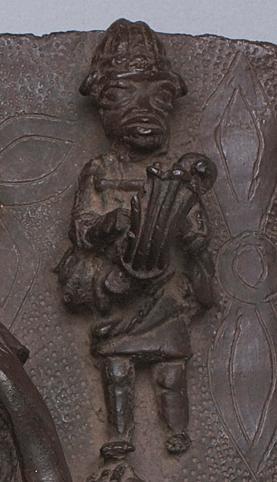To the right of the Oba is a bearded man wearing a high-crowned hat, boots, pleated jerkin, patterned hose, musket and hammer. This man is a Portuguese trader or soldier, one of many who might have aided the Oba in a war campaign or handled trade in a nearby port. The king of Portugal sent missionaries and military advisors to establish supportive relations, particularly during the reign of Oba Esigie (1517-66), who, European records suggest, was baptized as a youth in 1516 and relied on Portuguese allies to help secure his right to the throne. Guns were used for the first time in his war against the powerful Atah of Idah. Esigie adapted certain aspects of a ceremony known as Ague to focus on self denial and sacrifice, partly to reflect his respect for Catholic Lent. Over time, however, his alliance with the Portuguese soured, and when the Portuguese king sent missionaries in 1538 to baptize new converts, the Oba refused to allow it.
Detail of Portuguese figure, 81.17.496
Photo: Paul Macapia
Photo: Paul Macapia
Detail of attendant with ekpokin, 81.17.496
Photo: Kathy Curnow
Benin chiefs presenting the Oba with gifts inside an ekpokin, 1994
Kneeling beside the Oba, an attendant carries a ceremonial sword of state, or eben, which is used to demonstrate loyalty to the Oba. To kneel is a sign of true allegiance. It is considered degrading except when required for ritual purposes. One of the punctuation points in court ceremonies is the tossing and twirling of eben, an event that still occurs. The presentation offers striking embellishment to the spectacles of art, costume and dance that occur at the palace. A demonstration can be seen on the Media page of this website.
Detail of sword bearer, 81.17.496
Photo: Paul Macapia
An akpotin, or harp player, appears in the top right corner of the plaque. The akpata, the player's instrument, is used for telling stories and producing music during ceremonies in Benin. It has six or seven strings, each of which is named.
Detail of harp player, 81.17.496
Photo: Paul Macapia
Photo: Kathy Curnow
Clockwise from right: the Oba (holding eben), a guard, and the Oba's eldest daughter
A group of three court officials flank the Oba, offering a reminder that the Oba is reliant on the support of his subjects. Personal and domestic servants of the Oba have many official duties, including shielding him whenever he makes public appearances.
Detail showing court officials, 81.17.496
Photo: Paul Macapia
Leaves are carefully incised into the background of this and other plaques. Their presence raises a question about the original inspiration for the plaques. Some sources connect the leaf pattern with a river plant whose healing properties are used in the kingdom. Others point out that the word for leaf also refers to book and paper, and that books may have influenced the format and use of plaques as repositories for historical records. Further evidence for this relationship is the fact that the first brass plaques were created during the reign of Oba Esigie, an innovator who could read and speak Portuguese by the early sixteenth century.
Plaques were fastened to pillars that supported the massive flat ceilings of the palace buildings, and the brass was kept brightly polished. About nine hundred plaques are known to exist in public and private collections, with the largest assembly displayed at the British Museum. By the time of the British Punitive Expedition in 1897, however, the plaques were not installed on the pillars but were consulted on questions of court procedure.
Detail of leaf pattern background, 81.17.496
Photo: Paul Macapia











